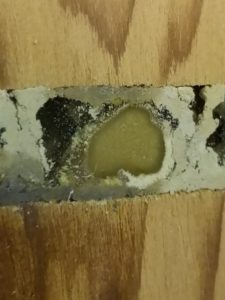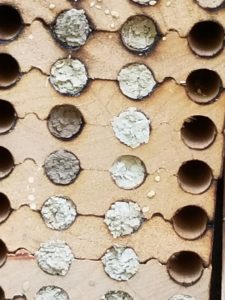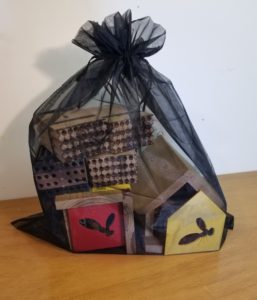Bee management is all about keeping your bees safe and healthy. At this time of year, late June, most mason bees have stopped flying and nesting trays need to be stored in a wasp-proof bag or in an outbuilding.
In late June, most mason bees are at their end. They have either died in the field or have died inside one of the nesting tunnels.
In the spring, bees emerged, collected pollen and nectar for their offspring, collected mud to prepare their nests and laid eggs. These eggs ate the provisions of pollen and nectar left behind by their female mason bee.

Pollen provisions for young bee placed between mud plugs.
Then, after they had eaten all their provisions, each bee grub or larvae turned into a bee pupae. This is a resting phase so that their bodies are ready for the next step. The next step is where each bee pupae turns into an adult bee inside a cocoon. All these steps are completed inside the nesting tunnels but only if temperatures are relatively warm- about 20-30C/ 70-90F.

It is summer time when mud plugs are visible.
When you notice that mason bees have stopped flying- around mid June, it is time to store them while they develop into adults during warm temperatures of the summer months. Of course, you may think all bees have done their job, but you might be surprised that there are still some mason bees about that are still producing offspring. If this is the case, come back and check in another week or so.

Don’t store nests until all mason bees have stopped flying.
As mentioned above nesting trays need to be stored at temperatures above 20C so that developing bees can continue to develop into the final adult bee. There are two ways that I have successfully stored nesting trays until harvest time in the fall:
1) The best location to store nesting trays with developing bees is in an outbuilding with a window. Again temperatures should be between 20-30C. Of course more than 30C would be a bit high. The advantage of the window is that when the tiny parasitic wasps emerge from the parasitized cocoons they go to the light at the window and no longer parasitize additional cocoons.
2)
2) If there are no out buildings available, I usually take nests down and place them under a verandah where it is nice and dry, but still warm. Under these storage conditions, you need net bags for your nesting trays to prevent wasp parasitism and additional re-infestations by the parasitic wasps.
Procedure for placing nesting trays into storage: -Remove nesting trays from housing. -Do not drop nesting trays.
-Do not turn nesting trays upside down.
-Keep nesting trays as a unit.
-Do not open nesting trays by removing tape.
-Gently take nesting trays to the storage site until harvest in October.
-If storage site is in an open area and not inside a building place nesting trays into a Wasp proof bag. Keep your bees safe with a Wasp-proof bag. A bonus- it is on special.

